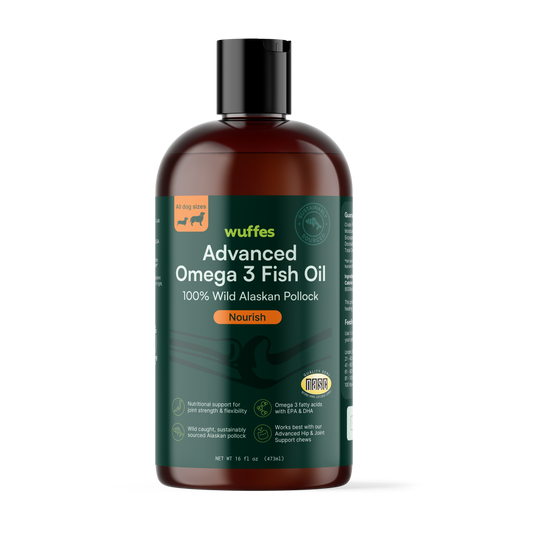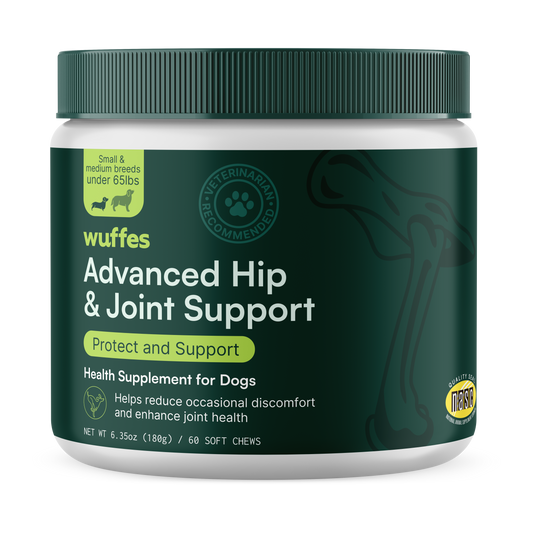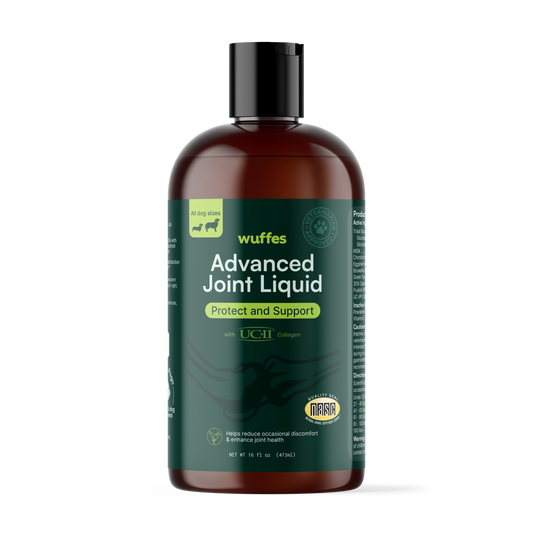Osteoarthritis (OA) is the most common cause of chronic pain in dogs, affecting an estimated one in five pets.[1][2] Many myths still shape how owners and even some professionals respond to mobility changes. Clearing the fog means earlier help and happier, longer lives for our furry friends.
Myth 1 - “If my dog isn’t crying, he's not in pain”
Reality: Chronic pain in animals rarely triggers vocalization. Instead look for: limping or “bunny‑hopping,” slower stairs, stiff rising, changes in sleep positions, or grumpiness when touched. Alterations in how your dog moves are often their way of avoiding positions that cause pain. Except in rare cases, a limp equals pain until proven otherwise.
Myth 2 - “Arthritis only happens to old dogs”
Reality: One study found OA in 40% of dogs up to four years old.[3] Developmental conditions such as elbow and hip dysplasia lead to OA long before the muzzle grays. Cruciate disease (“ACL” tears) is another leading cause of OA and usually occurs at 3-7 years of age.[4]
Myth 3 - “Big dogs get arthritis - small dogs don’t”
Reality: While the incidence of joint disease is higher in large breed dogs,[5] toy breeds can develop osteoarthritis too. Small dogs with an underlying joint disease such a cranial cruciate ligament rupture (“ACL” tear) or medial patellar luxation are especially prone to developing OA.[6]
Myth 4 - “The only treatments for OA are rest and anti-inflammatories”
Reality: Effective OA management is multimodal - weight loss, tailored low‑impact exercise, pain management, joint injections, and targeted supplements all stack for bigger gains than any single tool. Dogs with hip OA who received 60 minutes of total regular exercise per day have been shown to have lower lameness scores than those getting less than 20 minutes of exercise per day.[7]
Myth 5 - “If my dog isn’t that fat, weight‑loss won’t really help”
Reality: Fat tissue is not only dead weight, but also inflammatory. Dropping just 6–8% body‑weight lowers pro‑inflammatory cytokines and measurably reduces lameness.[8] Lean Labradors have been shown to have delayed OA onset by six years compared with heavier littermates.[9]
Myth 6 - “All joint supplements are the same”
Reality: Supplements are not FDA regulated. And many supplements have been shown to contain minimal if any of the ingredients claimed by labels.[10]
- Check the seals. Look for the National Animal Supplement Council (NASC) Quality Seal and “current Good Manufacturing Practice (cGMP).” These marks mean the factory follows strict safety rules and batch‑tests every lot.
- Know your active ingredients. Omega‑3s, UC‑II collagen, and green‑lipped mussel all are backed by OA studies in dogs. [11]
Myth 7 - “You don’t need X‑rays to diagnose OA”
Reality: Hands‑on exams can raise suspicion of OA, but X-rays are critical to confirm bony change and rule out mimics like tumors or fractures. Conversely, the absence of an abnormal X-ray could be helpful in ruling out OA in cases of soft tissue or neurological disease.
Myth 8 - “Swimming is always the best exercise”
Reality: Hydrotherapy can be a great low-impact workout for dogs with OA, but only when the dog is confident, the session is timed, and water entry/exit are controlled to prevent injury. Depending on the joint affected, swimming may not be the most effective way to improve range of motion. Consult a rehab therapist for guidance on what is best for your dog.
Myth 9 - “Stem‑cell injections can regrow new cartilage and cure arthritis”
Reality: If only this were true. Intra‑articular (in the joint) stem‑cells can reduce pain and improve weight‑bearing in many dogs, but published trials show symptom relief, not full cartilage regrowth.[12][13] As with other therapies, they’re best viewed as one piece of a broader strategy, not a silver bullet.
Myth 10 - “If an older dog is slowing down, it has to be arthritis”
Reality: Arthritis is common, but it’s not the only culprit. Slow rising, dragging toes, or wobbling can signal spinal cord disease. Your vet can do a neurological exam and may recommend an MRI or CT scan to spot these issues.
Key Take-aways
- Limping is pain. Early diagnosis (with X-ray) and intervention are key.
- Osteoarthritis is best managed using a multimodal approach including exercise, weight loss, pain management, and joint supplementation.
- Choose supplements with GMP/NASC quality assurance.
Ready to help your dog move easier? Talk to your veterinarian to build a personalized, multimodal arthritis plan.
References
- Johnston, S. A. (1997). Osteoarthritis Joint Anatomy, Physiology, and Pathobiology. Veterinary Clinics of North America: Small Animal Practice, 27(4), 699–723. https://doi.org/10.1016/s0195-5616(97)50076-3
- Wright, A., Amodie, D. M., Cernicchiaro, N., Lascelles, B. D. X., Pavlock, A. M., Roberts, C., & Bartram, D. J. (2022). Identification of canine osteoarthritis using an owner‐reported questionnaire and treatment monitoring using functional mobility tests. Journal of Small Animal Practice, 63(8), 609–618. https://doi.org/10.1111/jsap.13500
- Enomoto, M., Castro, N. de, Hash, J., Thomson, A., Nakanishi-Hester, A., Perry, E., Aker, S., Haupt, E., Opperman, L., Roe, S., Cole, T., Thompson, N. A., Innes, J. F., & Lascelles, B. D. X. (2024). Prevalence of radiographic appendicular osteoarthritis and associated clinical signs in young dogs. Scientific Reports, 14(1), 2827. https://doi.org/10.1038/s41598-024-52324-9
- Witsberger, T. H., Villamil, J. A., Schultz, L. G., Hahn, A. W., & Cook, J. L. (2008). Prevalence of and risk factors for hip dysplasia and cranial cruciate ligament deficiency in dogs. Journal of the American Veterinary Medical Association, 232(12), 1818–1824. https://doi.org/10.2460/javma.232.12.1818
- Anderson, K. L., Zulch, H., O’Neill, D. G., Meeson, R. L., & Collins, L. M. (2020). Risk Factors for Canine Osteoarthritis and Its Predisposing Arthropathies: A Systematic Review. Frontiers in Veterinary Science, 7, 220. https://doi.org/10.3389/fvets.2020.00220
- Villatoro, A. S., Langenbach, A., Yoon, J., Garcia, T. C., & Marcellin‐Little, D. J. (2023). Stifle joint osteoarthritis in small‐breed and medium‐breed dogs is more severe after cranial cruciate ligament injury than medial patellar luxation. Veterinary Radiology & Ultrasound, 64(3), 385–392. https://doi.org/10.1111/vru.13207
- Greene, L. M., Marcellin-Little, D. J., & Lascelles, B. D. X. (2013). Associations among exercise duration, lameness severity, and hip joint range of motion in Labrador Retrievers with hip dysplasia. Journal of the American Veterinary Medical Association, 242(11), 1528–1533. https://doi.org/10.2460/javma.242.11.1528
- Marshall, W., Hazewinkel, H., Mullen, D., Meyer, G. D., Baert, K., & Carmichael, S. (2010). The effect of weight loss on lameness in obese dogs with osteoarthritis. Veterinary Research Communications, 34, 241–253.
- Smith, G. K., Paster, E. R., Powers, M. Y., Lawler, D. F., Biery, D. N., Shofer, F. S., McKelvie, P. J., & Kealy, R. D. (2006). Lifelong diet restriction and radiographic evidence of osteoarthritis of the hip joint in dogs. Journal of the American Veterinary Medical Association, 229(5), 690–693. https://doi.org/10.2460/javma.229.5.690
- Adebowale, A. O., Cox, D. S., Liang, Z., & Eddington, N. D. (2000). Analysis of glucosamine and chondroitin sulfate content in marketed products and the Caco-2 permeability of chondroitin sulfate raw materials. J Am Nutraceutical Assoc, 3(1), 37–44.
- Barbeau-Grégoire, M., Otis, C., Cournoyer, A., Moreau, M., Lussier, B., & Troncy, E. (2022). A 2022 Systematic Review and Meta-Analysis of Enriched Therapeutic Diets and Nutraceuticals in Canine and Feline Osteoarthritis. International Journal of Molecular Sciences, 23(18), 10384. https://doi.org/10.3390/ijms231810384
- Olsson, D. C., Teixeira, B. L., Jeremias, T. D. S., Réus, J. C., Canto, G. D. L., Porporatti, A. L., & Trentin, A. G. (2021). Administration of mesenchymal stem cells from adipose tissue at the hip joint of dogs with osteoarthritis: A systematic review. Research in Veterinary Science, 135, 495–503. https://doi.org/10.1016/j.rvsc.2020.11.014
- Thoene, M., Bejer-Olenska, E., & Wojtkiewicz, J. (2023). The Current State of Osteoarthritis Treatment Options Using Stem Cells for Regenerative Therapy: A Review. International Journal of Molecular Sciences, 24(10), 8925. https://doi.org/10.3390/ijms24108925
Dr. Jennifer Repac, DVM DACVSMR












